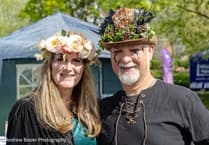Part of the fascination of wildlife watching for me, is observing the changes that take place in nature as time progresses. A great example of this would be my visits to the old railway line at Torrington in North Devon.
When I came here in May, swifts were screeching as they swooped by the old station house where they were nesting under the eaves. Alongside the old track bed, brambles were out in flower – their delicate pink blooms attracting a wide variety of bees and hover flies. In a nearby wood I could hear the distinctive ‘chip, chip’ calls of great spotted woodpeckers. I made my way over to investigate and came across a breeding pair who had made their nest in a large tree.
Recently, I had the chance to return to Torrington to observe the changes since my visit in May. The swifts had all gone, no doubt winging their way back to South Africa for the winter. The blossoms on the bramble bushes had been replaced by an abundance of blackberries in various stages of development. And the site of the woodpecker’s nest lay silent and abandoned. The skies were still full of swallows and house martins, but it won’t be long before they too will be making their way back to Africa along with all the other summer migrants. This is all part of the fascination I find in watching wildlife; it’s always on the move. And as long as we conserve it, it always will be.
LB LOXLEY




Comments
This article has no comments yet. Be the first to leave a comment.